Huayan Temple is located in Huayan Village, Huayan Town, Jiulongpo District, Chongqing Municipality. It is a national 4A-level tourist attraction. With a long history and a large-scale architectural complex, the scenic area covers an area of 160,000 square meters. Huayan Temple is renowned for its unique Buddhist culture and beautiful natural landscapes. The architectural style inside the temple is simple and elegant, featuring numerous halls, monks' quarters, and other buildings. Backed by the mountains of Huayan Scenic Area, the temple is surrounded by interdependent mountains and waters, presenting a beautiful scenery. It is a tourist resort integrating Buddhist culture, natural landscapes, and humanistic landscapes.
History and Culture
There are different views on the founding era of Huayan Temple, and it is generally believed to have been founded during the Tang and Song Dynasties, with a history of over a thousand years. During the Ming and Qing Dynasties, the scale of Huayan Temple continued to expand, becoming an important Buddhist sacred site in the eastern Sichuan region. Throughout the long course of history, Huayan Temple has undergone numerous renovations and expansions. During the Kangxi and Qianlong reigns of the Qing Dynasty, Huayan Temple entered a peak period of development, where many eminent monks resided and propagated Buddhism.
Since modern times, while preserving Buddhist traditions, Huayan Temple has actively carried out cultural exchanges and social public welfare activities. During the War of Resistance Against Japanese Aggression, Huayan Temple once served as a shelter, protecting many people. After the founding of the People's Republic of China, Huayan Temple has received attention and protection from the government. In recent years, continuous renovations and maintenance have been carried out, ensuring the inheritance and development of its Buddhist culture and architectural art.
Major Attractions
Outdoor Golden Buddha
The Outdoor Golden Buddha is a statue of Sakyamuni Buddha, the founder of Buddhism. It stands 16 meters tall, with a steel frame structure supporting its interior. The Buddha's body is forged from copper plates 2 millimeters thick, and the entire body is covered with 24K pure gold foil. A total of 100 tons of brass was used for the golden Buddha. The base of the golden Buddha is an octagonal building; the interior is the Ten Thousand Buddhas Hall, housing small golden Buddha statues. The outer walls are carved with 6 stories of the Buddha's life, each made from a single piece of white marble, condensing Sakyamuni's life from birth, enlightenment, preaching to nirvana. Behind the golden Buddha, there are 6 stone scripture pillars, on which the entire Diamond Sutra (more than 6,000 characters) is carved. On the worshipping square in front of the golden Buddha, the trees on both sides are lush and dense, pruned to be higher on the left and lower on the right. Using landscape gardening techniques, this forms a protective formation of "Azure Dragon on the left and White Tiger on the right".
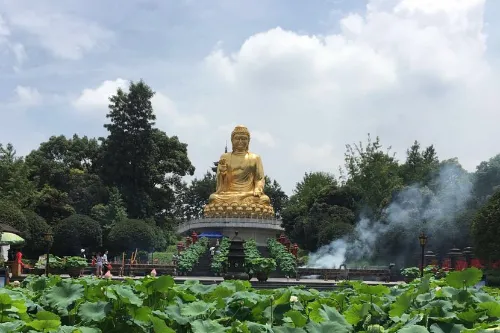
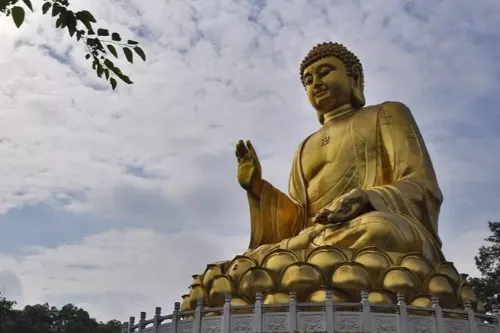
Mahavira Hall
The Mahavira Hall is the core building of the temple, with a magnificent momentum. Adopting the traditional Chinese architectural style, the hall features upturned eaves and interlocking brackets. Inside the hall, there are solemn Buddha statues, which are exquisitely shaped and crafted with superb techniques. The Mahavira Hall is the venue where Huayan Temple holds major Buddhist rituals, and numerous believers and tourists come to worship and visit every day.
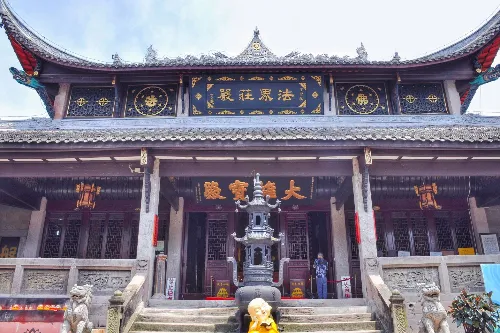
Huayan Lake
Huayan Lake is located beside Huayan Temple. The lake water is clear, and the surrounding area is shaded by lush trees. There are various fish and waterfowl in the lake, presenting a pleasant scenery. Tourists can walk along the lake to enjoy the beautiful landscape of the lake and mountains, or rest in the pavilions and towers by the lake. Huayan Lake and Huayan Temple set off each other, forming a beautiful landscape painting of mountains and waters.
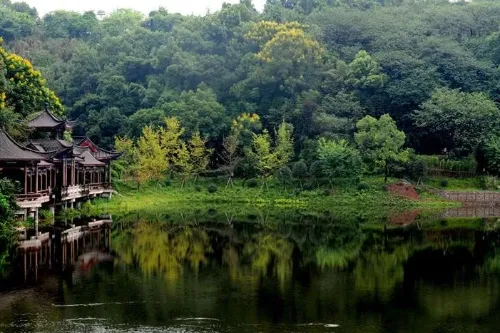
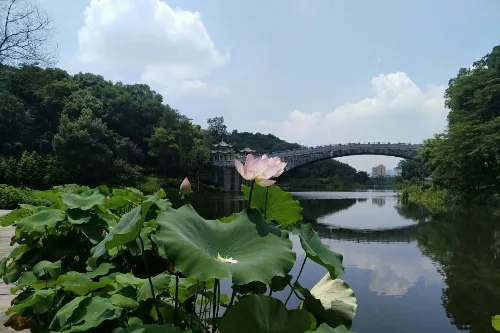

Seven-Buddha Pagoda
The Seven-Buddha Pagoda is one of the landmark buildings of Huayan Temple, with a height of approximately 26 meters. The pagoda body is exquisitely carved, and seven Buddha statues are enshrined inside. With a simple and unsophisticated shape, the Seven-Buddha Pagoda possesses high artistic value. Tourists can climb to the top of the pagoda to overlook the scenery of Huayan Temple and its surrounding areas, enjoying a broad view.
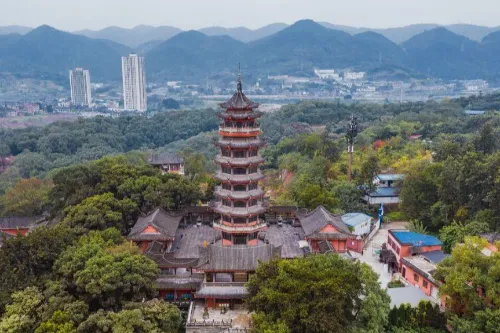
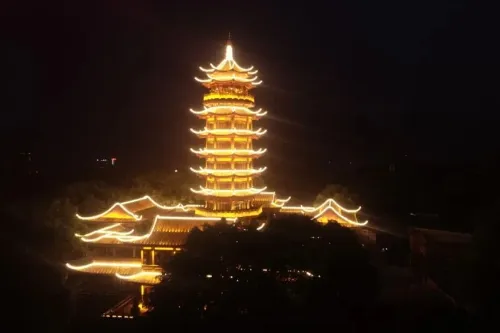
Avalokitesvara Courtyard
The Avalokitesvara Courtyard of Huayan Temple is surrounded by mountains on three sides, with a horseshoe-shaped terrain backed by mountains and adjacent to water. On the high platform at the rear of the courtyard's axis, there stands a 21.9-meter-tall statue of Vairocana Avalokitesvara Bodhisattva. Below it, there are 33 incarnate statues of Avalokitesvara Bodhisattva arranged in two layers.
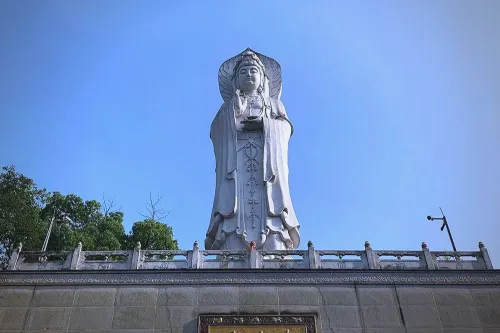
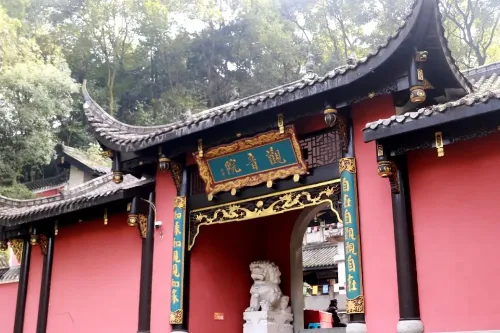
Huayan Cave
Huayan Cave is the origin of Huayan Temple's name. Located on the rock mountain to the west of the temple, it is a natural limestone cave. The entrance of the cave is about 3 meters high and 4 meters wide, with a depth of approximately 20 meters and an area of around 150 square meters. According to historical records, Monk Huale in the early Tang Dynasty once practiced meditation in this cave. Inside the cave, there are dozens of cliff carvings dating back to the Tang Dynasty, including Buddhist scriptures, Buddha statues, and inscriptions by famous figures. Among them, the stone carving of the two characters "Huayan" (meaning "Flowery Rock") was inscribed by Master Shengke during the Wanli reign of the Ming Dynasty. With vigorous and forceful calligraphy, it is an important witness to the historical culture of Huayan Temple.
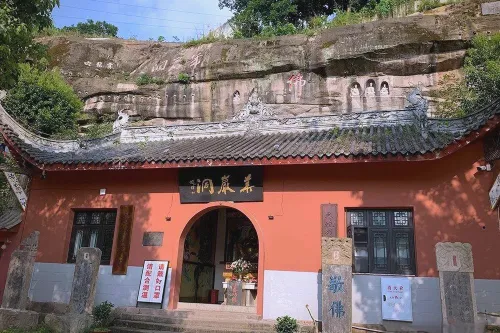
Jieyin Hall (Hall of Reception)
Jieyin Hall is located in front of the Mahavira Hall and serves as the mountain gate hall of Huayan Temple. Founded in the Qing Dynasty, the existing building was restored in the 1990s in accordance with the architectural style of the Qing Dynasty. It covers an area of approximately 300 square meters and is about 12 meters high. Inside the hall, there is a statue of Amitabha Buddha in the posture of receiving believers. The Buddha statue is about 4 meters tall, crafted using copper casting technology, and the entire body is gilded. The posture of the Buddha statue, with both hands extended to receive, symbolizes "guiding all living beings to the Pure Land".
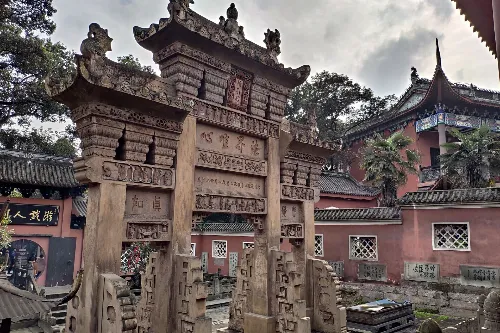
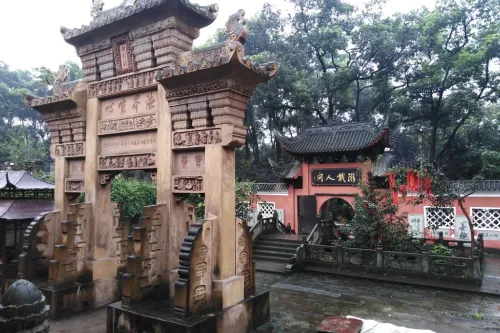
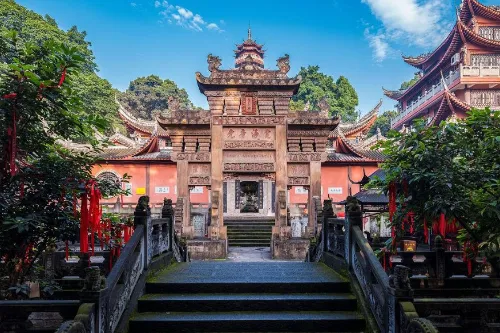
Tour Route
After entering Huayan Temple Scenic Area, tourists can first visit the Mahavira Hall to learn about Buddhist culture and architectural art. Then, head to Huayan Lake to enjoy the scenery of the lake and mountains, and take a walk or rest by the lake. Next, go to the Seven-Buddha Pagoda and climb to the top to overlook the scenic area. After that, visitors can tour other halls in Huayan Temple, such as the Avalokitesvara Hall and the Arhat Hall. After the visit, taste local delicacies like Huayan vegetarian food inside the temple or in the surrounding area.
Travel Tips
- When entering Huayan Temple, visitors should dress appropriately, avoiding overly revealing or disrespectful clothing to show respect for Buddhist culture and religious sites.
- Keep quiet during the visit and do not make loud noises to avoid disturbing other tourists and believers.
- Photography may be prohibited in some areas of Huayan Temple. Tourists should abide by relevant regulations and not take photos randomly.
- When tasting Huayan vegetarian food, order according to personal needs to avoid waste and experience the frugality spirit of Buddhism.
- If you want to participate in Buddhist rituals in the temple, you can learn about the event time and requirements in advance and participate in accordance with the regulations.
Notes
- Huayan Temple is a religious activity site. Tourists should respect Buddhist beliefs and religious customs and refrain from behaviors that disrespect the religion.
- Smoking, drinking alcohol, or consuming meaty food are not allowed inside the temple to maintain the purity and cleanliness of the temple.
- During the visit, take good care of the cultural relics, historic sites, and public facilities in the temple. Do not touch or damage them randomly.
- Follow the guidance and arrangements of the staff and abide by the rules and regulations of the scenic area.
- If you encounter problems or need help in the scenic area, you can consult or seek assistance from the staff.
Transportation
- Bus: You can take bus routes such as Route 203, 204, 222, 223, 224, 268, 425, 428, 469, and 843, and get off at Huayan Temple Station.
- Subway: Take Rail Transit Line 5, get off at Huayan Temple Station, and walk to the scenic area after exiting from the corresponding exit.
- Self-driving: Navigate to "Huayan Temple". There are parking lots around the scenic area for parking. However, parking spaces may be tight during holidays or when there are many tourists.
Opening Hours
Huayan Temple is open year-round, with opening hours from 08:00 to 17:00. The opening hours may be adjusted during special festivals or when major Buddhist activities are held. It is recommended that tourists pay attention to the official announcement of the scenic area in advance.
Tickets
Admission to Huayan Temple is free, and tourists can enter and visit for free. However, certain fees may be charged for some activities or venues according to actual circumstances. For specific information, please refer to the announcement of the scenic area.


